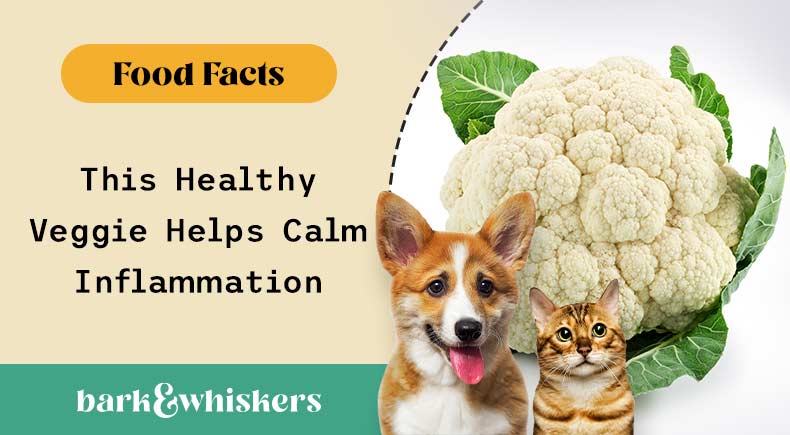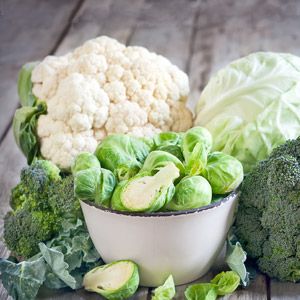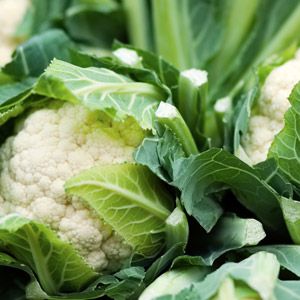Cauliflower: This Healthy Veggie Helps Calm Inflammation
Just like broccoli, this cruciferous vegetable contains a powerful compound that can stimulate over 200 genes and has multiple benefits. Here's how to share it with your pets.

STORY AT-A-GLANCE
- Cauliflower and other cruciferous vegetables like Brussels sprouts contain sulforaphane, which has chemopreventive properties, according to animal studies
- This compound activates a protein called Nrf2 in your pet's body. As a result, it stimulates over 200 genes and triggers hundreds of beneficial reactions, such as managing inflammation, stimulating the body's natural antioxidant production and promoting detoxification
- Cauliflower is a good source of antimutagens, which may help minimize the risk of cancer, according to several studies
- Choline, which is found in cauliflower, may help support healthy brain development, heart health, liver and muscle function, as well as nervous system function
Editor's Note: This article is a reprint. It was originally published May 5, 2022.
Cauliflower has become widely popular among health enthusiasts because of its nutrients and versatility — no doubt you've seen one or two versions of "cauliflower rice" or "cauliflower risotto" being featured on your favorite recipe sites. Most everyone knows about this cruciferous vegetable's many health benefits, brought on by its high fiber and antioxidant content, but have you ever wondered if your pet can eat it too?
The good news is, yes — cauliflower can be a great pet treat or a component of your pet's nutritionally balanced, species-appropriate homemade diet. It can be a great food topper or ingredient added to your pet's meals. Keep on reading to learn what benefits your pets can get from cauliflower.
Cauliflower Fun Facts

Cauliflower is actually a flower that hasn't fully developed yet. It belongs to the Brassicaceae plant family and is related to cabbage, broccoli, turnips and Brussels sprouts.1
Cauliflower Is Rich in Antioxidants
Just like other cruciferous vegetables, cauliflower is a rich source of natural antioxidants such as carotenoids, tocopherols and ascorbic acid (vitamin C), which are known to help protect against damage caused by reactive oxygen species.2
Brassica vegetables like cauliflower are also a good source of antimutagens, which may help minimize the risk of cancer, according to several studies.3 Isothiocyanates, which are "naturally occurring small molecules that are formed from glucosinolate precursors of cruciferous vegetables," have been found to exhibit antitumor properties by "affecting multiple pathways including apoptosis, MAPK signaling, oxidative stress, and cell cycle progression."4 In a separate study conducted on rats, isothiocyanates were found to block tumor formation in the test subjects.5
Sulforaphane: The Mighty Component in Cauliflower
Another plant compound found in cauliflower and other cruciferous vegetables like broccoli and Brussels sprouts is sulforaphane, which has chemopreventive properties, according to animal studies.6 This compound also activates a protein called Nrf2 in your pet's body. As a result, it stimulates over 200 genes and triggers hundreds of beneficial reactions, such as managing inflammation, stimulating the body's natural antioxidant production and promoting detoxification.7
Sulforaphane may also help protect against toxins and help manage conditions like epilepsy, hepatic encephalopathy and spinal cord injury.8 A study in diabetic rats found that it protects memory aptitude as well.9
Which State Produces the Most Cauliflower?

In the U.S., California is the top cauliflower-producing state — at least 90% of the supply is grown there. Arizona comes in second place and Oregon in third.10

Cauliflower Also Contains Choline and Fiber
Like humans, dogs produce some choline, but not enough to meet all their body's requirements, which is why it's an essential nutrient for dogs. Choline, which is found in cauliflower, may help support healthy brain development, heart health, liver and muscle function, as well as nervous system function.
Choline works as a building block of acetylcholine, which is a neurotransmitter that helps regulate muscle contractions, dilation of blood vessels and heart rate.11 Aside from cruciferous vegetables, other sources include wild caught Alaskan salmon, organic pastured chicken, grass fed beef liver and shitake mushrooms.
Fiber is another beneficial component found in cauliflower, with 0.26 grams found in every two-tablespoon serving.12 It's essential for building the microbiome and provides roughage for optimal bowel health. However, cats and dogs only need a small amount of fiber in their diets, which can be achieved if you feed them a nutritionally balanced, species-appropriate diet, including low-glycemic vegetables like cauliflower.
Did You Know?

Cauliflower wasn't grown in the U.S. until the 1900s. It's believed to have originated from Asia, around the Mediterranean Sea. In Europe, it's been grown and eaten since the 1500s.13
How to Give Cauliflower to Your Pets
"When feeding cauliflower to pets, make sure that you serve it plain and without any seasonings."
While it's OK to feed raw, too much raw cauliflower may lead to gas or digestive problems, so it may be best to lightly cook it by boiling or steaming (the healthiest option). Serve it in small bites or mash and use as a food topper.14 You can also feed bite-sized pieces of cauliflower as treats, but make sure that all treats only constitute 10% of your pet's daily caloric intake.
Is Cauliflower a Sustainable Food Choice?
Brassica vegetables are among the foods with the lowest greenhouse emissions, according to a blog article published in Shelf Engine,15 and part of the reason is that only some parts of the plant are used. Parts of cauliflower and other brassicas are not harvested and are essentially composted — they go back to the earth. This minimizes their overall carbon load, as the returned parts are added back into the soil where they can benefit future harvests — they put more carbon back into the soil than they emit.16
Cauliflower ranks No. 31 in the Environmental Working Group's (EWG) Dirty Dozen list for 2022, meaning it has moderate amounts of pesticide residues.17 However, it's still best to choose non-GMO and organic varieties, as industrially grown veggies can still expose you and your pets to pesticides. Whenever possible, seek out organically grown cauliflower from farmers markets.
Try This Healthy Treat Recipe That Uses Cauliflower
Cauliflower can be fed to your pets as treats or added to homemade treats, like my Cushing's Cookies recipe. This special treat contains ingredients that are functional foods, which help to naturally reduce the adrenal gland's overproduction of sex hormones and cortisol.
Cushing's Cookies
Ingredients:
- 1/2 cup high lignan flax hulls*
- 1/2 cup chopped mushrooms (shiitake, maitake or any pet-safe variety)
- 1/2 cup steamed cauliflower, chopped or mashed
- 1/4 cup minced raw, unsalted pumpkin (pepita) seeds
- 2 cups lean ground beef
- 1 egg
Directions:
- Blend all the ingredients together. Roll into 1-inch balls, and then press into cookies.
- Place on a greased cookie sheet and bake at 350°F for 25 minutes. Allow to cool before serving to your pets.
Store extra cookies in the freezer or refrigerator and consume within one week. If stored in the freezer, these can stay fresh for up to three months.
*You can buy this from a health food store or online. Ground flax powder or flaxseeds do not confer the adrenal-balancing benefits of flax hulls, so specifically buy high lignan flax hulls if your pet is dealing with elevated cortisol issues.
Sources and References
- 1,13 USDA Wisconsin Department of Public Health, Cauliflower
- 2,3 Biomed Res Int. 2013;2013:367819. doi: 10.1155/2013/367819. Epub 2013 Sep 22
- 4 Acta Pharmacol Sin. 2009 May; 30(5): 501–512
- 5 Cancer Res. 1994 Apr 1;54(7 Suppl):1976s-1981s
- 6 Mol Nutr Food Res. 2013 Dec; 57(12): 10.1002/mnfr.201300210., Abstract
- 7 American Journal of Pharmacology and Toxicology 3(1):152-159, March 2008
- 8 Brain Circ. 2019 Apr-Jun; 5(2): 74–83, Stroke and Injury, Epilepsy, Other Diseases, Toxins
- 9 Cell Physiol Biochem. 2016;39(3):901-7, Abstract
- 10 AGMRC, Cauliflower, August 2021
- 11 Wag!, Choline for Dogs
- 12 USDA Food Data Central, Cauliflower, Raw
- 14 Prrs and Wags by Pumpkin, September 8, 2021
- 15 Shelf Engine, September 3, 2021
- 16 UK Research and Innovation, March 30, 2009
- 17 EWG's 2022 Shopper's Guide to Pesticides in Produce™











